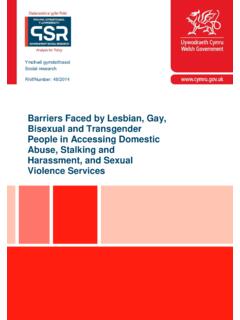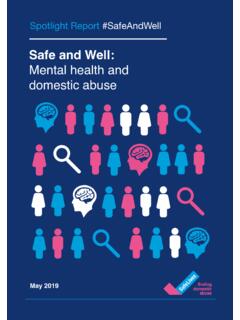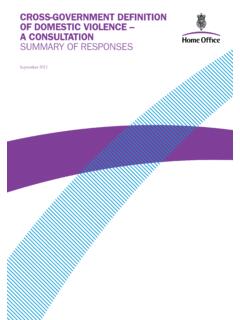Transcription of 2021 report on gender equality in the EU
1 Justiceand ConsumersFREE THRIVE LEAD2021 report on gender equality in the EUEN EN The European Commission is not liable for any consequence stemming from the reuse of this publication. European Union, 2021 The reuse policy of European Commission documents is implemented based on Commission Decision 2011/833/EU of 12 December 2011 on the reuse of Commission documents (OJ L 330, , p. 39). Except otherwise noted, the reuse of this document is authorised under a Creative Commons Attribution International (CC-BY ) licence ( ). This means that reuse is allowed provided appropriate credit is given and any changes are indicated. For any use or reproduction of elements that are not owned by the European Union, permission may need to be sought directly from the respective rightholders. 1 Contents INTRODUCTION ..2 FREE FROM violence AND STEREOTYPES ..4 Impact of Covid-19 on gender -based violence ..4 Ending gender -based violence .
2 7 Online violence ..8 Harassment in the world of work .. 10 Female genital mutilation, honour-related violence .. 11 Trafficking in human beings .. 12 Supporting victims of gender -based violence .. 14 Challenging stereotypes through prevention and education .. 15 THRIVING IN A gender -EQUAL ECONOMY .. 19 Impact of Covid-19 on women s participation in the labour market .. 19 Women s participation in the labour market .. 23 Segregated labour markets and undervaluation across different sectors of the economy .. 26 Closing the gender gap in pay and 29 Improving work-life balance and narrowing the gender care gap .. 31 LEADING EQUALLY THROUGH SOCIETY .. 35 gender balance in decision making during the COVID-19 pandemic .. 35 Women in political decision-making .. 40 gender MAINSTREAMING .. 44 COVID-19 Response .. 45 Strengthening gender mainstreaming at EU level .. 47 Strengthening gender mainstreaming in the EU s new long-term budget.
3 49 An intersectional approach to gender equality .. 51 Monitoring the gender equality Strategy .. 52 PROMOTING gender equality AND WOMEN S EMPOWERMENT ACROSS THE WORLD .. 53 EU s global response to the COVID-19 pandemic .. 53 The EU s new roadmap for a gender equal world .. 55 The EU s external action against gender -based violence .. 56 EU s global partnerships and action on gender equality and women s empowerment .. 57 gender mainstreaming in EU s external action .. 58 CONCLUSION .. 60 2 INTRODUCTION One year ago, on 5 March 2020, the Commission adopted its gender equality Strategy 2020-2025. The strategy was the first deliverable on President von der Leyen s commitment to a Union of equality . It sets out an ambitious framework for the next 5 years, formally endorsed by the Commission, on how to advance gender equality in Europe and beyond. The strategy is based on a vision for a Europe where women and men, girls and boys, in all their diversity, are free from violence and stereotypes and have the opportunity to thrive and to lead.
4 This is the first report under the new strategy. It takes stock of where the EU and its Member States stand on gender equality one year after the adoption of the Strategy. It sets out the EU s achievements and gives inspiring examples from the Member States and EU-funded projects for each of the strategy s five key areas: Being free from violence and stereotypes Thriving in a gender equal economy Leading equally throughout society gender mainstreaming and funding Promoting gender equality and women s empowerment across the world. The past year has been marked by the COVID-19 pandemic, which has proven to be a major challenge for gender equality . The pandemic has exacerbated existing inequalities between women and men in almost all areas of life, both in Europe and beyond. The report presents the available data on the gendered impact of the COVID-19 crisis for each area of the strategy and outlines the measures the EU and Member States have taken to mitigate these effects.
5 Despite the challenges arising from the COVID-19 crisis, the Commission made significant efforts to move forward with the implementation of the gender equality Strategy over the past year. It stepped up its fight against gender -based violence by publishing, in June 2020, it s first-ever EU victims rights strategy and by launching, in February 2021, an open public consultation on a new legislative initiative to better support victims and prosecute perpetrators of gender -based violence . It also continued its efforts to accede to the Istanbul Convention. The Commission addressed the issue of online violence with its proposal for a Digital Services Act, adopted in December 2020, which clarifies the responsibilities of online platforms, thereby contributing to making the internet safer for women. With the adoption of the proposal for a Directive strengthening the equal pay principle through pay transparency and enforcement mechanisms in early March 2021, the Commission has taken a major step to improve the respect of the right to equal pay and tackle pay discrimination.
6 Also in early March 2021, the Commission adopted an Action Plan to implement the European Pillar of Social Rights, which puts gender equality at its core and establishes, amongst others, ambitious targets for women s participation in the labour market and the provision of early childhood education and care which is very important in this context. In the 2020 Digital Education Action Plan and the European Skills Agenda, the Commission announced a range of actions to ensure that girls and young women participate equally in ICT studies and develop their digital skills. The Commission itself made progress on women s participation in politics and increased female representation in decision-making, with the first-ever gender -balanced College of Commissioners in the EU s history. The Commission also strengthened gender equality and women s empowerment outside of the EU through the new gender 3 Action Plan (GAP III) for 2021-2025.
7 The new multi-annual financial framework for 2021-2027 promotes gender - equality both through strengthened gender mainstreaming and targeted actions of specific EU spending programmes. The Next Generation EU recovery instrument requires Member States to explain how the measures in their national recovery plans will contribute to gender equality , thus ensuring a gender equal and fair recovery in the EU. The implementation of the gender equality Strategy takes a dual approach comprising gender mainstreaming and targeted measures to address gender inequality. As intersectionality is a horizontal principle for its implementation, the strategy is reflected in the other equality strategies that have followed after it. This includes the EU Roma strategic framework for equality , inclusion and participation for 2020- 2030, the LGBTIQ equality strategy 2020-2025, the EU Anti-racism action plan 2020-2025 and the Strategy on the rights of persons with disabilities 2021-2030.
8 4 FREE FROM violence AND STEREOTYPES At the core of gender inequalities, gender -based violence continues to be an endemic problem disproportionately affecting women and The perpetrator is an intimate partner for one in five women experiencing such acts2 and in over half of the female murder victim The most recent results of the Fundamental Rights Survey further confirm this phenomenon from the perspective of a broader experience on crime. Women are more likely to experience incidences of violence occurring within the household, of sexual nature and perpetrated more often by a family member or gender -based violence constitutes a major barrier in the path toward gender equality . It is a violation of the victim s human rights, dignity and, in the worst cases, right to life. Amid growing threats to gender equality , amplified by the outbreak of COVID-19 and its socio-economic consequences, ending gender -based violence is a key EU policy objective.
9 It remains among the main goals of the EU gender equality strategy for 2020-2025. Impact of Covid-19 on gender -based violence The COVID-19 pandemic has amplified existing gender -based violence against women, confirming long-standing research findings that the risk of domestic violence tends to increase in times of Lockdown measures were set to keep people safe at home. However, home turned out not to be safe for everyone and lockdown measures played a demonstrable role in the significant increase in reports of domestic violence and an increase in gender -based violence overall6. While the collection of robust EU-level data is ongoing, preliminary findings from an assortment of independently carried-out studies point towards an escalation of psychological and physical violence against women by an intimate partner7. In spring 2020, several EU Member States recorded a surge in 1 One in three women in the EU aged 15 or over has suffered physical and/or sexual violence , one in two have been sexually harassed, around two in five women has endured psychological violence and 1 in 10 has been subject to online harassment, European Union Agency for Fundamental Rights, violence against women: an EU-wide survey, 2014, p.
10 21. Available at This survey is still the most up-to-date source of information on gender -based- violence in the EU. In 2020, the Commission launched a new survey, coordinated by EUROSTAT, to provide up-to-date data on gender -based violence , see p. 16 for details. 2 Ibid. 3 European Parliamentary Research Service, violence against women in the EU: State of play, 2019, p. 2. Available at (2018) 4 European Union Agency for Fundamental Rights, Fundamental Rights Survey: Crime, Safety and Victims Rights, Luxembourg: Publications Office of the European Union, 2021, Available at: 5 World Health Organization, violence and disasters, 2005. Available at 6 World Health Organization, The rise and rise of interpersonal violence an unintended impact of the COVID-19 response on families, 2020. Available at: United Nations, WHO warns of surge of domestic violence as COVID-19 cases decrease in Europe, UN Regional Informational Centre for Western Europe, 2020, available at: 7 Arenas-Arroyo, E.














